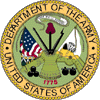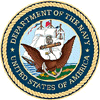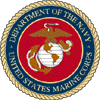| |
As
the title of this paper suggests, the researchers intend to determine
whether military command information newspapers meet the objectives
they claim to advocate. The objectives of each of the four services
are similar and comply with DoD guidance. Many questions in the
readership survey administered by the Tinker AFB Oklahoma City
Air Logistics Center public affairs office were designed to test
whether the Take Off met military objectives. Since the survey
asked many questions on a four or five-point ordinal scale, one
could average the scores for those questions to arrive at a possible
answer; however, simply calculating the means of scores will not
produce significant or useful results for the reader of this project
without examining the factors that influence or have an impact
on whether military newspapers meet their objectives. Therefore,
the research question is the following:
1. Do independent variables, such as age, gender, marital status,
rank, how long has one worked on base, amount of education and
newspaper use influence whether military newspapers meet the objectives
they advocate?
Participants
From a base population of approximately 24,000 people, Tinker
AFB Oklahoma City Air Logistics Center public affairs distributed
surveys to a sample of 2,400, all of whom are military, civilians,
retirees, or family members of people affiliated with Tinker.
PA received 254 responses for a response rate of 10.58-percent.
The Capstone researchers randomly selected 175 surveys to analyze.
Of the 175 people who returned surveys, 13 answered they never
read the Take Off, which accounted for 7.4-percent of all respondents.
The rest of the sample answered that they at least read the paper
occasionally. The survey asked people who responded “never”
to skip all questions about the newspaper and proceed to questions
about demographics, while the people who replied that they read
it at least occasionally were asked to complete the entire questionnaire.
Procedure
Codebook. The researchers developed a codebook on SPSS for the
six-page survey developed by the public affairs office at Tinker
entitled, Tinker Take Off Readership Survey (see appendix 1).
Since some of the questions were multi-part and others asked respondents
to mark all that apply. The researchers grouped together items
on the survey to form measures.
Operationalization. From the objectives of Air Force newspapers
in AFI 35-101, 5.7. Establishing Air Force Newspapers and from
items in the survey, the researchers created eight variables to
measure. They used the Take Off as a sample to generalize about
military newspapers in general.
These variables were the following: the extent to which the base
newspaper provided recognition of excellence in performance; information
about the base; information about the Air Force; photos and graphic
illustrations; mission-essential information to members of the
command; information to improve quality of life; information to
promote command cohesiveness; and information on personnel-related
issues. The researchers grouped the items accordingly, arranging
them by identical scales, since survey questions must have identical
scales to be grouped together. The Tinker survey incorporated
questions with many different types of scales. For example, some
questions comprised ordinal data and asked the respondent to select
one of five possible answers, while others incorporated ordinal
data with one of four possible answers. Still others asked people
to choose one of three or even six.
Table 1. Items in Survey Selected to Measure Objectives
|
| |
| Objective |
Item |
Question |
| Recognition
1 |
19 |
In
terms of the amount of stories, rate the Tinker Take Off at
recognizing local people with stories and photos. |
| |
20 |
In
terms of the quality of stories, |
| |
|
|
| Base
Information |
21 |
In
terms of the amount of information, how would you rate the
Tinker Take Off as a source of information about the base? |
| |
22
|
In
terms of the quality of information, |
| |
|
|
| USAF
Information |
23 |
In
terms of the amount of the stories, how would you rate the
Tinker Take Off as a source of information about the Air Force? |
| |
24 |
In
terms of the quality of the stories, |
| |
|
|
| Visual
Rating |
25 |
In
terms of the amount of photos and graphic illustrations, how
would you rate the Tinker Take Off? |
| |
26 |
In
terms of the quality of photos and graphic illustrations, |
| |
|
|
| Essential
Information |
|
How
well do you think the Tinker Take Off does in providing you
sufficient information on the following topics? |
| |
27 |
Air
Force Leadership |
| |
28 |
Air
Force People and Modernization |
| |
35 |
Unit
deployments |
| |
36 |
Joint
service operations |
| |
38 |
Current
operations |
| |
40 |
Recruiting
and retention |
| |
41 |
Drawdowns |
| |
44 |
Air
Force doctrine |
| |
50 |
Chapel |
| |
51 |
Aircraft |
| |
52 |
Technology |
| |
53 |
Air
Force policy |
| |
|
|
| Recognition
2 |
|
How
well do you think the Tinker Take Off does in providing you
sufficient information on the following topics? |
| |
37 |
Personal
recognition |
| |
43 |
Institutional
awards |
| |
|
|
Quality of Life |
|
How
well do you think the Tinker Take Off does in providing you
sufficient information on the following topics? |
| |
31 |
Housing |
| |
32 |
Health
care |
| |
33 |
Child
care |
| |
54 |
Base
crime |
| |
55 |
Base
recreational activities |
| |
|
|
| Cohesion |
|
How
well do you think the Tinker Take Off does in providing you
sufficient information on the following topics? |
| |
46 |
Sports |
| |
47 |
Local
events |
| |
48
|
Base
services |
| |
|
|
| Personnel |
|
How
well do you think the Tinker Take Off does in providing you
sufficient information on the following topics? |
| |
34 |
Retirement
benefits |
| |
39 |
Financial
news |
| |
42
|
Promotions |
The research allowed for two recognition variables because the
survey defined recognition in two ways. The first recognition
variable in this analysis will measure how readers rate the amount
and quality of stories in the Take Off that recognize base people,
while the second variable will measure the extent to which people
think the paper provides sufficient information on personal recognition
and institutional awards. Both support one of the Air Force’s
key objectives for the base paper, which is to provide recognition
of excellence in performance.
|



